Anonymous1 (talk | contribs) No edit summary |
m (Standardize wikitext) |
||
| (105 intermediate revisions by 10 users not shown) | |||
| Line 1: | Line 1: | ||
[[File:Kids2.JPG|thumb|450px|Fig 1: Kids in the Garden]] | |||
== Abstract == | |||
Sprouting Education was a group of students from Cal Poly Humboldt partaking in a design project in [[Engr205 Introduction to Design]] in Spring 2011. Sprouting Education worked with Locally Delicious to create a garden for elementary schools to use. The team of four was given 3 months to build an interactive garden that could be implemented in schools across the USA.The final design incorporated materials that could be donated or acquired from scrap yards to create three versatile designs that schools could adapt to their needs. | |||
== Background == | |||
[[Locally Delicious]] is a group of women determined to help the nation eat healthier and locally. For their second book "Lunchbox Envy", Locally Delicious focuses on motivating students across the nation to eat healthier and learn about local agriculture. | |||
Sprouting Education formed in the Environmental Engineering Design class at Cal Poly Humboldt in Spring 2011 to design a school garden for Locally Delicious' [[Lunchbox Envy]] book. Sprouting Education has designed a school garden for grades 4-8 that will teach students how to grow their own food. The garden is made of materials that can be donated or found at scrap yards and can be constructed in a weekend, making it a versatile design that can be implemented in schools across the nation. The variety of features displayed in Trillium Children's Garden, allows schools to choose any one of the features that are appropriate for their site. | |||
== | ==== Project Statement ==== | ||
The objective of Sprouting Education was to design and build an interactive school garden for students to learn the benefits and values of sustainable agriculture. The final design encourages students to eat healthier by empowering them to produce their own food. | The objective of Sprouting Education was to design and build an interactive school garden for students to learn the benefits and values of sustainable agriculture. The final design encourages students to eat healthier by empowering them to produce their own food. | ||
==Project Criteria== | == Project Criteria == | ||
{| class="wikitable" | {| class="wikitable" | ||
! Criteria | ! Criteria | ||
! Description | ! Description | ||
| Line 27: | Line 25: | ||
| 10 | | 10 | ||
|- | |- | ||
|Participant Safety | | Participant Safety | ||
| Students will be protected from any hazardous structure from the garden | | Students will be protected from any hazardous structure from the garden | ||
| 10 | | 10 | ||
| Line 43: | Line 41: | ||
| 8 | | 8 | ||
|- | |- | ||
|Sufficient Produce | | Sufficient Produce | ||
|The potential to produce enough produce for students to find the garden rewarding | | The potential to produce enough produce for students to find the garden rewarding | ||
|7 | | 7 | ||
|- | |- | ||
|Easy Maintenance | | Easy Maintenance | ||
|Simplicity to maintain the garden during the summer and school year | | Simplicity to maintain the garden during the summer and school year | ||
|6 | | 6 | ||
|- | |- | ||
|Plant | | Plant Safety | ||
|Plants will be protected from any harm or destruction | | Plants will be protected from any harm or destruction | ||
|2 | | 2 | ||
|- | |- | ||
| Expandability | |||
| The design of the garden is accessible for any additional expansion | |||
| 1 | |||
|} | |} | ||
==Final Project Design== | == Final Project Design == | ||
The final project design is a collection of different styles of gardens which will entertain and enlighten kids about the benefits of local agriculture. | |||
The rainwater catchment system is simply a | [[File:Image5.jpeg|thumb|center|350px|Fig 2: Final garden design; Raised bed with a greenhouse top, kiddie pools, and a rainwater catchment system]] | ||
The final project design is a collection of different styles of gardens which will entertain and enlighten kids about the benefits of local agriculture. Trillium Children's Garden is composed of a variety of three garden aspects, the rainwater catchment system, kiddie pool garden, and pallet garden with greenhouse top. The rainwater catchment system is simply a pickle bin posted beneath the gutter of the school which catches and stores rainwater for treating the garden. The raised bed is a 4 X 12 ft garden made of half-cut wooden pallets and geotextile fabric against the inner perimeter of the pallets to secure the soil in place. | |||
[[File:SE Garden.jpg|thumb|center|350px||Fig 3: First draft design; Raised beds, potato bin, kiddie pools, and rainwater catchment system]] | |||
On top of the raised bed are PVC pipes bent across, outlining the structure for the greenhouse top to lie in place. The plastic sheeting serves as our green house top sheeting which is simple laid over the pipes and locked down in place with bungee hooks. A wooden dowel is attached to the ends of the plastic sheeting. These dowels provide as a tool for one to easily roll up the sheeting to the top of the hoop, help up by clamps, so one can work in the garden. The two Kiddie-Pools will be filled with soil as its own transferable garden. | |||
Diagrams will be scattered around the garden to illustrate concepts such as the plant life cycle and the process of photosynthesis to educate the kids about the science behind their garden. | |||
== Costs == | |||
The costs involved in creating the Sprouting Education Garden come in two forms: hours of labor and materials costs. | The costs involved in creating the Sprouting Education Garden come in two forms: hours of labor and materials costs. | ||
===Design Hours=== | === Design Hours === | ||
The chart to the right shows the breakdown of design hours that went into constructing the Sprouting Education School Garden. A majority of the hours were spent | |||
The chart to the right shows the breakdown of design hours that went into constructing the Sprouting Education School Garden. A majority of the hours were spent in the construction phase. | |||
[[File:Doc1.jpg|thumb|400px|right]] | |||
===Building and Materials Costs=== | === Building and Materials Costs === | ||
Below are the costs of materials to construct the garden. The total building and design costs without donations were $697.34. A local cookie factory, Desserts on Us, donated the wooden pallets we needed and Pierson's Building Center donated a hose, 5 - 12' PVC Pipes, A 50 Gallon Pickle Barrel and 48' Re-bar bringing the group's total cost to only $270.63. | |||
{| class="wikitable" | |||
! Materials | |||
! Quantity | |||
! Cost Per Quantity $ | |||
! Our Cost $ | |||
! Potential Cost $ | |||
|- | |||
| Sand Paper-Grade 80 | |||
| align="right"|2 | |||
| align="right"|1.19 | |||
| align="right"|1.19 | |||
| align="right"|2.57 | |||
|- | |||
| U-Clamps | |||
| align="right"|20 | |||
| align="right"|1.33 | |||
| align="right"|26.60 | |||
| align="right"|26.60 | |||
|- | |||
| 12' rebar | |||
| align="right"|4 | |||
| align="right"|8.99 | |||
| align="right"|0.00 | |||
| align="right"|35.96 | |||
|- | |||
| 50' Hose | |||
| align="right"|1 | |||
| align="right"|16.99 | |||
| align="right"|16.99 | |||
| align="right"|16.99 | |||
|- | |||
| 50 Gal. Pickle Barrel | |||
| align="right"|1 | |||
| align="right"|30.00 | |||
| align="right"|0.00 | |||
| align="right"|30.00 | |||
|- | |||
| Wooden Pallets | |||
| align="right"|16 | |||
| align="right"|19.50 | |||
| align="right"|0.00 | |||
| align="right"|312.00 | |||
|- | |||
| 100x10 Ft Geotextile fabric | |||
| align="right"|1 | |||
| align="right"|30.00 | |||
| align="right"|0.00 | |||
| align="right"|30.00 | |||
|- | |||
| Plastic Cover | |||
| align="right"|1 | |||
| align="right"|8.88 | |||
| align="right"|8.88 | |||
| align="right"|8.88 | |||
|- | |||
| Screws per lb | |||
| align="right"|1 | |||
| align="right"|3.59 | |||
| align="right"|3.59 | |||
| align="right"|3.59 | |||
|- | |||
| 1" Diameter 12' PVC Pipe | |||
| align="right"|5 | |||
| align="right"|1.05 | |||
| align="right"|0.00 | |||
| align="right"|5.25 | |||
|- | |||
| Bungee Cord Mini 10" 8 pack | |||
| align="right"|1 | |||
| align="right"|6.82 | |||
| align="right"|6.82 | |||
| align="right"|6.82 | |||
|- | |||
| Washer | |||
| align="right"|1 | |||
| align="right"|1.34 | |||
| align="right"|1.34 | |||
| align="right"|1.34 | |||
|- | |||
| Thermometer (Wall) | |||
| align="right"|1 | |||
| align="right"|2.96 | |||
| align="right"|2.96 | |||
| align="right"|2.96 | |||
|- | |- | ||
| Drill Bit 1-1/8" | |||
| align="right"|1 | |||
| align="right"|4.29 | |||
| align="right"|4.29 | |||
| align="right"|4.29 | |||
|- | |- | ||
| | | Metal Strap | ||
| | | align="right"|1 | ||
| | | align="right"|2.06 | ||
| | | align="right"|2.06 | ||
| | | align="right"|2.06 | ||
|- | |- | ||
| | | Couple Hose Nylon Shut Off | ||
| | | align="right"|1 | ||
| | | align="right"|3.86 | ||
| | | align="right"|3.86 | ||
| | | align="right"|3.86 | ||
|- | |- | ||
| | | PVC Adapter | ||
| | | align="right"|1 | ||
| | | align="right"|1.79 | ||
| | | align="right"|1.79 | ||
| | | align="right"|1.79 | ||
|- | |- | ||
| | | Flew Jaw Spring Clamp 6" | ||
| | | align="right"|2 | ||
| | | align="right"|1.50 | ||
| | | align="right"|3.00 | ||
| | | align="right"|3.00 | ||
|- | |- | ||
| | | Paint (Pilgrim Blue) | ||
| | | align="right"|1 | ||
| | | align="right"|31.98 | ||
| | | align="right"|31.98 | ||
| | | align="right"|31.98 | ||
|- | |- | ||
| 1 | | Paint (Off Tint) | ||
| | | align="right"|1 | ||
| | | align="right"|15.00 | ||
| | | align="right"|15.00 | ||
| | | align="right"|15.00 | ||
|- | |- | ||
| | | Poly Paint Brush Set | ||
| | | align="right"|1 | ||
| | | align="right"|5.99 | ||
| | | align="right"|5.99 | ||
| | | align="right"|5.99 | ||
|- | |- | ||
| | | Soil 1-1/2 Cu Yds | ||
| | | align="right"|1 | ||
| | | align="right"|60.00 | ||
| | | align="right"|0.00 | ||
| | | align="right"|60.00 | ||
|- | |- | ||
| | | Gas | ||
| | | align="right"|1 | ||
| | | align="right"|150.00 | ||
| | | align="right"|150.00 | ||
| | | align="right"|150.00 | ||
|- | |- | ||
| | |||
| | |||
| align="right"|'''Total Costs''' | |||
| align="right"|270.63 | |||
| align="right"|697.34 | |||
|} | |} | ||
===Expected Maintenance Costs=== | === Expected Maintenance Costs === | ||
The system was designed to require as little maintenance as possible, although normal garden maintenance will need to be upheld to guarantee the success of the garden. | The system was designed to require as little maintenance as possible, although normal garden maintenance will need to be upheld to guarantee the success of the garden. | ||
{| class="wikitable | {| class="wikitable" | ||
! Task | ! Task | ||
! Time (hrs/wk) | |||
|- | |- | ||
| Water Garden | | Water Garden | ||
|align="right"| | | align="right"| 2.0 | ||
|- | |- | ||
| | | Weeding Garden | ||
|align="right"| | | align="right"| 1.0 | ||
|- | |- | ||
| | | pH and Nutrient Top-Off | ||
|align="right"| | | align="right"| 0.5 | ||
|- | |- | ||
| | | Soil Tilling | ||
|align="right"| | | align="right"| 0.5 | ||
|- | |- | ||
! Total Time | |||
|align="right"| ''' | | align="right"| '''4.0''' | ||
|} | |} | ||
== | == Testing Results == | ||
Our project design was tested on April 22, 2011 for Trillium Charter's School celebration of Earth day. The school's day activity was to plant seeds of vegetables into our raised bed with a greenhouse top garden. Prior to actual seeding, the students were able to gather together, un-hook and roll up the plastic sheeting (green house top) to the top of the raised bed in order to start tending the garden. Each child had a seed to plant in our pallet raised bed garden and watered the seeds using our rainwater catchment system. After watering, the kids were capable of rolling down the plastic sheeting down on their own and hooking them back into place. | |||
[[File:Group Photo.jpg|thumb|350px|Team Photo]] | |||
== Building and Implementation Instructions == | |||
[http://openpario.mime.oregonstate.edu/attachments/4097/Movie.wmv Instructional Video] | |||
[[Trillium Children's Garden Instruction]] | |||
== | == Discussion == | ||
By including reusable materials, interactive mediums, and educational displays, Trillium Children's Garden inspires students to grow their own food and eat healthy. | |||
Schools across the nation will be able to create a school garden, by recreating our simple and sustainable garden design. The design's easy implementations and use of reusable materials will encourage school's to start building a garden for their students, leading them the path of learning and experiencing sustainable agriculture. | |||
{{Page data}} | |||
[[Category:Locally Delicious]] | |||
[[Category:Engr205 Introduction to Design]] | |||
[[Category:Gardening]] | |||
Latest revision as of 19:20, 22 August 2023
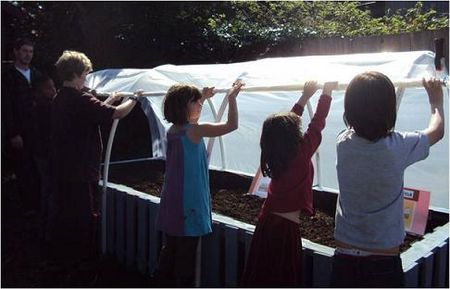
Abstract[edit | edit source]
Sprouting Education was a group of students from Cal Poly Humboldt partaking in a design project in Engr205 Introduction to Design in Spring 2011. Sprouting Education worked with Locally Delicious to create a garden for elementary schools to use. The team of four was given 3 months to build an interactive garden that could be implemented in schools across the USA.The final design incorporated materials that could be donated or acquired from scrap yards to create three versatile designs that schools could adapt to their needs.
Background[edit | edit source]
Locally Delicious is a group of women determined to help the nation eat healthier and locally. For their second book "Lunchbox Envy", Locally Delicious focuses on motivating students across the nation to eat healthier and learn about local agriculture. Sprouting Education formed in the Environmental Engineering Design class at Cal Poly Humboldt in Spring 2011 to design a school garden for Locally Delicious' Lunchbox Envy book. Sprouting Education has designed a school garden for grades 4-8 that will teach students how to grow their own food. The garden is made of materials that can be donated or found at scrap yards and can be constructed in a weekend, making it a versatile design that can be implemented in schools across the nation. The variety of features displayed in Trillium Children's Garden, allows schools to choose any one of the features that are appropriate for their site.
Project Statement[edit | edit source]
The objective of Sprouting Education was to design and build an interactive school garden for students to learn the benefits and values of sustainable agriculture. The final design encourages students to eat healthier by empowering them to produce their own food.
Project Criteria[edit | edit source]
| Criteria | Description | Weight |
|---|---|---|
| Learning Potential | The ability to convey educational concepts from the garden to students | 10 |
| Participant Safety | Students will be protected from any hazardous structure from the garden | 10 |
| Reproducibility | The design of the garden is easily reproduced and transferable by others | 9 |
| Child Appeal | The aesthetics attract students to the garden | 8 |
| Cost | Reasonable price for overall material and labor | 8 |
| Sufficient Produce | The potential to produce enough produce for students to find the garden rewarding | 7 |
| Easy Maintenance | Simplicity to maintain the garden during the summer and school year | 6 |
| Plant Safety | Plants will be protected from any harm or destruction | 2 |
| Expandability | The design of the garden is accessible for any additional expansion | 1 |
Final Project Design[edit | edit source]
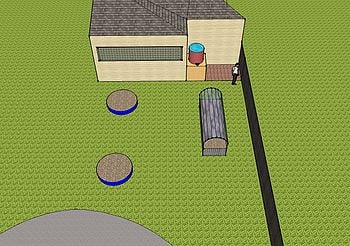
The final project design is a collection of different styles of gardens which will entertain and enlighten kids about the benefits of local agriculture. Trillium Children's Garden is composed of a variety of three garden aspects, the rainwater catchment system, kiddie pool garden, and pallet garden with greenhouse top. The rainwater catchment system is simply a pickle bin posted beneath the gutter of the school which catches and stores rainwater for treating the garden. The raised bed is a 4 X 12 ft garden made of half-cut wooden pallets and geotextile fabric against the inner perimeter of the pallets to secure the soil in place.
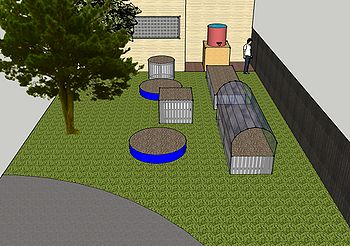
On top of the raised bed are PVC pipes bent across, outlining the structure for the greenhouse top to lie in place. The plastic sheeting serves as our green house top sheeting which is simple laid over the pipes and locked down in place with bungee hooks. A wooden dowel is attached to the ends of the plastic sheeting. These dowels provide as a tool for one to easily roll up the sheeting to the top of the hoop, help up by clamps, so one can work in the garden. The two Kiddie-Pools will be filled with soil as its own transferable garden.
Diagrams will be scattered around the garden to illustrate concepts such as the plant life cycle and the process of photosynthesis to educate the kids about the science behind their garden.
Costs[edit | edit source]
The costs involved in creating the Sprouting Education Garden come in two forms: hours of labor and materials costs.
Design Hours[edit | edit source]
The chart to the right shows the breakdown of design hours that went into constructing the Sprouting Education School Garden. A majority of the hours were spent in the construction phase.
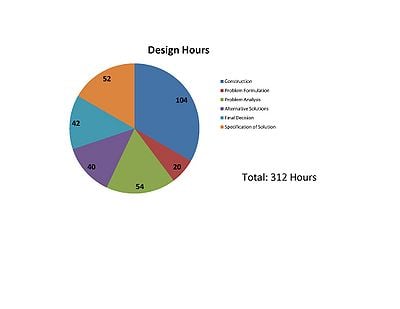
Building and Materials Costs[edit | edit source]
Below are the costs of materials to construct the garden. The total building and design costs without donations were $697.34. A local cookie factory, Desserts on Us, donated the wooden pallets we needed and Pierson's Building Center donated a hose, 5 - 12' PVC Pipes, A 50 Gallon Pickle Barrel and 48' Re-bar bringing the group's total cost to only $270.63.
| Materials | Quantity | Cost Per Quantity $ | Our Cost $ | Potential Cost $ |
|---|---|---|---|---|
| Sand Paper-Grade 80 | 2 | 1.19 | 1.19 | 2.57 |
| U-Clamps | 20 | 1.33 | 26.60 | 26.60 |
| 12' rebar | 4 | 8.99 | 0.00 | 35.96 |
| 50' Hose | 1 | 16.99 | 16.99 | 16.99 |
| 50 Gal. Pickle Barrel | 1 | 30.00 | 0.00 | 30.00 |
| Wooden Pallets | 16 | 19.50 | 0.00 | 312.00 |
| 100x10 Ft Geotextile fabric | 1 | 30.00 | 0.00 | 30.00 |
| Plastic Cover | 1 | 8.88 | 8.88 | 8.88 |
| Screws per lb | 1 | 3.59 | 3.59 | 3.59 |
| 1" Diameter 12' PVC Pipe | 5 | 1.05 | 0.00 | 5.25 |
| Bungee Cord Mini 10" 8 pack | 1 | 6.82 | 6.82 | 6.82 |
| Washer | 1 | 1.34 | 1.34 | 1.34 |
| Thermometer (Wall) | 1 | 2.96 | 2.96 | 2.96 |
| Drill Bit 1-1/8" | 1 | 4.29 | 4.29 | 4.29 |
| Metal Strap | 1 | 2.06 | 2.06 | 2.06 |
| Couple Hose Nylon Shut Off | 1 | 3.86 | 3.86 | 3.86 |
| PVC Adapter | 1 | 1.79 | 1.79 | 1.79 |
| Flew Jaw Spring Clamp 6" | 2 | 1.50 | 3.00 | 3.00 |
| Paint (Pilgrim Blue) | 1 | 31.98 | 31.98 | 31.98 |
| Paint (Off Tint) | 1 | 15.00 | 15.00 | 15.00 |
| Poly Paint Brush Set | 1 | 5.99 | 5.99 | 5.99 |
| Soil 1-1/2 Cu Yds | 1 | 60.00 | 0.00 | 60.00 |
| Gas | 1 | 150.00 | 150.00 | 150.00 |
| Total Costs | 270.63 | 697.34 |
Expected Maintenance Costs[edit | edit source]
The system was designed to require as little maintenance as possible, although normal garden maintenance will need to be upheld to guarantee the success of the garden.
| Task | Time (hrs/wk) |
|---|---|
| Water Garden | 2.0 |
| Weeding Garden | 1.0 |
| pH and Nutrient Top-Off | 0.5 |
| Soil Tilling | 0.5 |
| Total Time | 4.0 |
Testing Results[edit | edit source]
Our project design was tested on April 22, 2011 for Trillium Charter's School celebration of Earth day. The school's day activity was to plant seeds of vegetables into our raised bed with a greenhouse top garden. Prior to actual seeding, the students were able to gather together, un-hook and roll up the plastic sheeting (green house top) to the top of the raised bed in order to start tending the garden. Each child had a seed to plant in our pallet raised bed garden and watered the seeds using our rainwater catchment system. After watering, the kids were capable of rolling down the plastic sheeting down on their own and hooking them back into place.
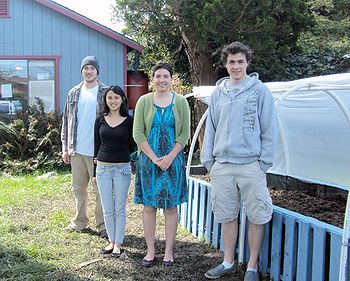
Building and Implementation Instructions[edit | edit source]
Trillium Children's Garden Instruction
Discussion[edit | edit source]
By including reusable materials, interactive mediums, and educational displays, Trillium Children's Garden inspires students to grow their own food and eat healthy. Schools across the nation will be able to create a school garden, by recreating our simple and sustainable garden design. The design's easy implementations and use of reusable materials will encourage school's to start building a garden for their students, leading them the path of learning and experiencing sustainable agriculture.